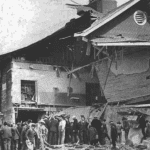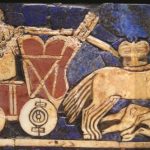 Music
Music  Music
Music  History
History 10 Less Than Jolly Events That Occurred on December 25
 Weird Stuff
Weird Stuff 10 Funny Ways That Researchers Overthink Christmas
 Politics
Politics 10 Political Scandals That Sent Crowds Into the Streets
 Weird Stuff
Weird Stuff Ten Bizarre Facts About The Doge Meme
 Our World
Our World 10 Ways Your Christmas Tree Is More Lit Than You Think
 Movies and TV
Movies and TV The 10 Coolest Stars to Set Sail on The Love Boat
 History
History 10 Things You Didn’t Know About the American National Anthem
 Technology
Technology Top 10 Everyday Tech Buzzwords That Hide a Darker Past
 Humans
Humans 10 Everyday Human Behaviors That Are Actually Survival Instincts
 Music
Music 10 Surprising Origin Stories of Your Favorite Holiday Songs
 History
History 10 Less Than Jolly Events That Occurred on December 25
 Weird Stuff
Weird Stuff 10 Funny Ways That Researchers Overthink Christmas
Who's Behind Listverse?

Jamie Frater
Head Editor
Jamie founded Listverse due to an insatiable desire to share fascinating, obscure, and bizarre facts. He has been a guest speaker on numerous national radio and television stations and is a five time published author.
More About Us Politics
Politics 10 Political Scandals That Sent Crowds Into the Streets
 Weird Stuff
Weird Stuff Ten Bizarre Facts About The Doge Meme
 Our World
Our World 10 Ways Your Christmas Tree Is More Lit Than You Think
 Movies and TV
Movies and TV The 10 Coolest Stars to Set Sail on The Love Boat
 History
History 10 Things You Didn’t Know About the American National Anthem
 Technology
Technology Top 10 Everyday Tech Buzzwords That Hide a Darker Past
 Humans
Humans 10 Everyday Human Behaviors That Are Actually Survival Instincts
10 Tragic and Shocking Facts about the White Ship Disaster
“No ship that ever sailed brought England such disaster” was the succinct way one historian summed up the tragic tale of the White Ship. He was writing in the 12th century, so he had no idea of the disaster that would be the Titanic. Even though the latter is more famous and resulted in more lives lost, the quote still holds true over 900 years later.
Unlike the “Blanche-Nef” or White Ship, the Titanic’s sinking certainly did not start any wars. But like the Titanic, and despite some conspiracy theories claiming otherwise, the White Ship disaster was a tragic accident. Here are ten true and terrible facts about England’s most consequential maritime tragedy.
Related: Top Ten Intriguing Shipwreck Mysteries That Were Recently Solved
10 The Heir to the Throne Died
Without modern materials and safety equipment, shipwrecks were quite common in the past. What was rare was for any single wreck to have major consequences for an entire country. The only way this could really happen was if its passengers were especially important, and that was definitely the case with the White Ship. Around 300 members of the Anglo-Norman nobility were said to be on board, including the only legitimate male heir to the throne, 17-year-old William Adelin.
William was the son of King Henry I, who had just spent four years at war with King Louis VI of France, which resulted in the latter’s defeat and acceptance of William as the rightful heir to the Dukedom of Normandy. Henry, William, and the rest of their entourage gathered at Barfleur in November 1120, ready to head back to England.
The king sailed ahead, not having any idea it would be the last time he would ever see his son. William was to sail on the ill-fated White Ship, which would result in his death by drowning in icy waters only a mile or so from the Norman coast.[1]
9 Only One Person Survived
Most of what is known about the tragedy which unfolded on the night of November 25, 1120, can be traced back to the account of the one man out of 300 who survived it. He was, surprisingly, not a member of the nobility—a fact which might well have helped save his life. He was a butcher named Berold, who had apparently ended up on board because he was chasing payments from the nobles who owed him money.
Unlike the fine robes that most of the passengers were sporting, Berold was wearing clothes made from cheap goat and sheep skins. These kept him warm enough to make it through the night in the freezing water, clinging to a piece of broken mast. He went on to live for another twenty years.[2]
8 Almost Everyone on Board Was Drunk
At this point, one is probably wondering what exactly made the ship sink. The answer is a toxic combination of two factors that can be just as deadly today as it was all those centuries ago: alcohol and responsibility for others’ lives. While King Henry set off ahead of William, the heir and the rest of the nobles were in high spirits, celebrating their successful campaign with copious amounts of wine.
As they boarded the Blanche-Nef, they were more than happy to share their drinks with the crew—even the helmsman—so that by the time the ship sailed, almost everyone on board was drunk. A lot of liquid courage had the effect of emboldening the sailors, and an order was given to try and overtake King Henry’s ship. The oarsmen gave it their all, and the sail was dropped even before the ship had gotten away from the dangerous rocky coastline. The ship sailed near full speed straight into a rock called the Quilleboeuf, an already notorious hazard.[3]
7 King Stephen Narrowly Avoided Sharing the Same Fate
Seeing the state of the crew and passengers on board the White Ship, a few sensible souls decided to disembark before the ship left for England. One of these was King Henry’s nephew, Stephen of Blois, who would later become King Stephen and leader of one side of the bitter civil war known as “The Anarchy,” which was a direct consequence of the White Ship disaster. Despite having 22 children, several of whom also perished that night, William was King Henry I’s only legitimate male heir.
After William died, Henry remarried and tried to have more children but was unsuccessful. So he named his only other legitimate child, Matilda, heir. Not keen on a female leader, many leading nobles supported Stephen in usurping his cousin in 1135. He reigned for almost twenty years but was constantly engaged in a chaotic war with Matilda and her supporters.
Things were so out of control the period would be known for the rest of history as “The Anarchy.” It eventually ended when Stephen agreed to recognize Matilda’s son as his heir, which put an end to the Norman dynasty, which had begun with William the Conqueror, replacing it with the Plantagenet era.[4]
6 William Could Have Escaped
King Henry I was not foolish enough to let his son and heir travel unguarded, and William’s bodyguards were not foolish enough to get drunk—at least not all of them—lest something happen to the young prince on their watch. This made the tale even more tragic, for William did not die in the initial wreck and was, in fact, safely on a lifeboat and set to escape.
However, he could hear his half-sister Matilda—the Countess of Perche, not to be confused with his legitimate sister Matilda—crying out for help. Unable to ignore her terrified screams, he ordered his men to row the lifeboat back to rescue her. This decision would have fatal consequences for everyone involved. As the already overcrowded lifeboat rowed back toward the wreck, even more people attempted to scramble aboard. Their weight overwhelmed the small boat, and it capsized, spilling William and the other would-have-been survivors back into the cold sea.[5]
5 The Captain’s Father Sailed William the Conqueror to England
The White Ship was not originally part of the group’s travel plans that evening. While they waited to depart in Barfleur, King Henry was approached by a local man called Thomas FitzStephen. The man explained that he was the captain of a ship called the Blanche-Nef, a ship noted for its elegance, beauty, and speed. It had just been refitted, and with a crew of 50 experienced oarsmen, it could have the king and his party back on English shores in no time.
What was more, FitzStephen was the son of the captain of the Mora, the ship that had brought William the Conqueror—Henry’s father and William’s grandfather—across from Normandy to England. However, with the royal vessel already waiting for him, Henry did not want to change his plans and declined the invitation. As a compromise, he suggested that FitzStephen invite his son William, some of his other illegitimate children, and numerous high-ranking members of the aristocracy and the church.[6]
4 The Captain Deliberately Drowned Himself
After young William Adelin’s lifeboat sank, only two survivors remained. Berold the butcher and a young nobleman called Geoffrey. They clung to a floating piece of mast. Geoffrey would not make it through the night, but he was apparently alive when Thomas FitzStephen, the ship’s captain, suddenly emerged from the sea after the initial chaos had subsided.
The captain asked the other two what had happened to the young prince. When they informed him that they were the only survivors, FitzStephen was in agony. Rather than face the king’s wrath, he declared that it would be “misery for me to live longer.” With that, he slipped below the surface again and let himself drown.[7]
3 The King Never Smiled Again
When news of the tragedy reached the king, he was devastated. The loss of his son and heir might have caused him the most grief of all, but with up to 300 lords and ladies on board, he had lost many others who were close to him, including some of his other children. Immediately upon receiving the news, the king reportedly fell to the ground and had to be carried to his chamber by his friends. He was screaming in anguish.
Although he lived another 15 years, he never fully got over the immense loss caused by the White Ship disaster. It is popularly said that he never smiled again. Some have speculated that it was trying to come to terms with this tragedy that led him to engage in acts of piety, such as ordering the construction of Reading Cathedral, where he was later buried.[8]
2 Priests Who Came to Bless the Ship Were Chased Away
With society in the 12th century being very religious, it is not surprising that there were members of the clergy among Henry and William’s party in Barfleur. But the priests were not only traveling with them, they had a practical purpose, too—blessing the ships to ensure that God would grant them safe passage to their destination.
It must have been a shock then for any god-fearing onlookers and the priests themselves when they arrived to bless the Blanche-Nef before it departed and were chased away by the drunken youngsters on board. A contemporary chronicler called Orderic Vitalis wrote that the priests were driven away “with contempt, amid shouts of laughter.” Of the fate of the merrymaking passengers and crew, he coldly reported that “they were speedily punished for their mockery.”[9]
1 The Ship’s Remains Were Recently Discovered
The tale of the White Ship disaster reportedly used to be so well known that historians even apologized for repeating it. Today, one could say it has sunk into relative obscurity. However, it did resurface in 2021 when a diving expedition discovered a 13-foot-long (3.96-meter) section of the ship’s hull. The British historian Earl Spencer calculated how long the ship would have rested on the Quilleboeuf rock after colliding with it. Using this information, a research team was able to analyze the sea’s currents and guess where the debris ended up.
During the dive, they identified the piece they found using the materials it was made from, which included iron, wood, and bronze. There were also no other recorded shipwrecks in the area where the debris was found. Although they only found a small piece, the real ship is believed to have been around 10 times the size of the piece they found, and it would have looked like a Viking longboat. It was among the biggest of its kind. Using pieces from the real ship, researchers plan to create both virtual and full-scale reconstructions.[10]








